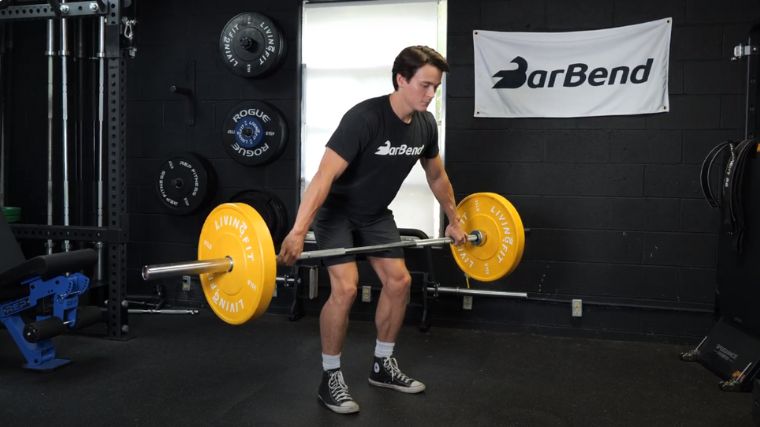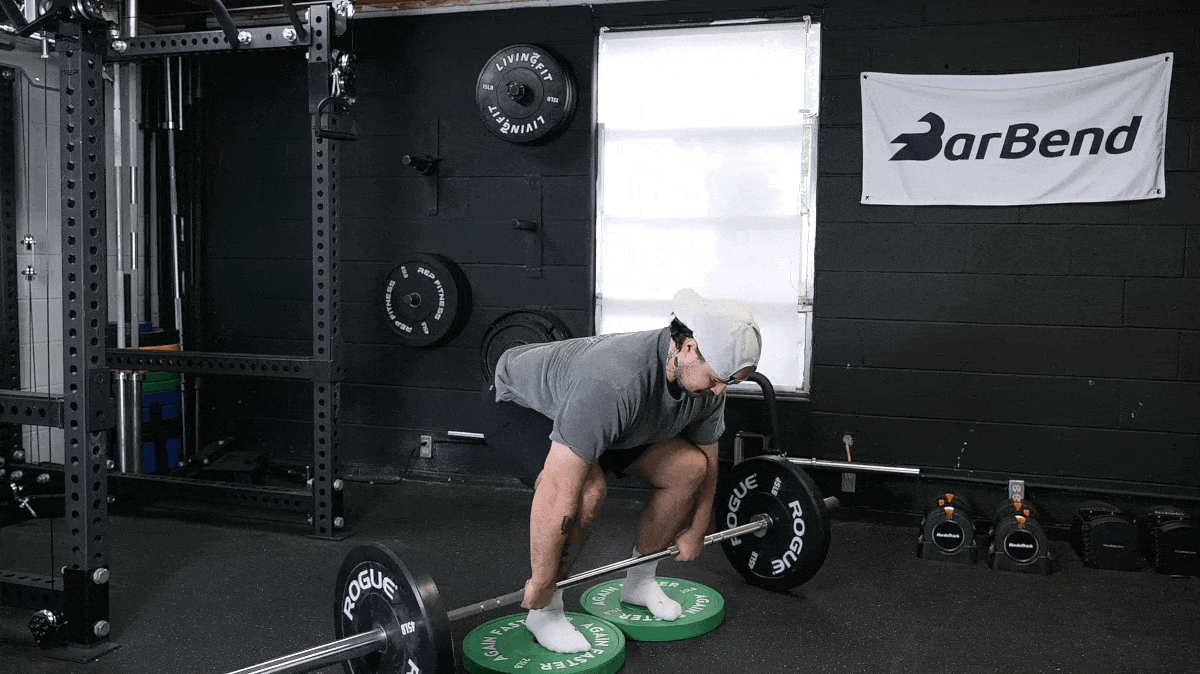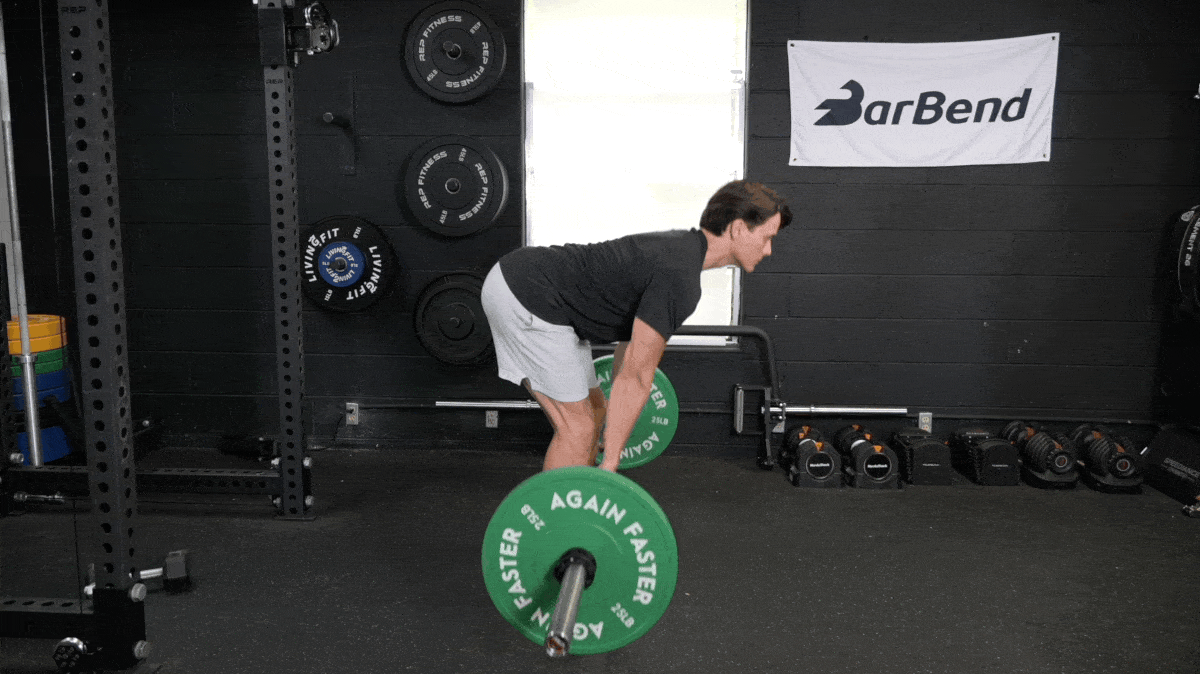We love the deadlift, and you should, too. Pulling weight from the floor strengthens your posterior chain (hips, glutes, hamstrings, and back), increases bone density, and reinforces one of the most fundamental movement patterns we engage in daily — the hip hinge. (1) Get your mitts around one of the best barbells and read on as outline deadlift strength standards and share some tips on how to improve your deadlift.
Key Takeaways
- A standard deadlift weight for women is 1.25 times your body weight, with the average female deadlift being 213.5 lbs for intermediate athletes.
- A standard deadlift weight for men is 1.75 times your body weight, with the average male deadlift being 349.7 lbs for intermediate athletes.
- Many factors go into determining these numbers, such as age, gender, and fitness level.
- Data is not listed for nonbinary athletes.
Deadlift Standards
Below, you’ll find a handful of charts detailing deadlift strength standards and averages for both male lifters and female lifters, as determined by both BarBend’s credentialed experts and our own research.
| Fitness Level | Male Standard | Female Standard |
| Beginner | BW | 0.50 x BW |
| Novice | 1.35 x BW | BW |
| Intermediate | 1.75 x BW | 1.25 x BW |
| Advanced | 2.15 x BW | 1.50 BW |
| Elite | 2.70 x BW | 2.00 x BW |
*BW refers to body weight
The weight amounts in all these charts reflect the one-rep maximum (1RM) for the corresponding body weight and gender. Along with consulting our in-house credentialed fitness experts, we researched other reputable sites — like Strength Log, Strength Level, and ExRx — to come up with these user-friendly, straightforward formulas. These formulas came from user-provided data on their body weight, gender, and deadlift maxes on popular fitness apps.
Average Deadlift for Men
| Fitness Level | Male Average Deadlift (lbs) |
| Beginner | 199.8 |
| Novice | 269.7 |
| Intermediate | 349.7 |
| Advanced | 429.6 |
| Elite | 539.5 |
Averages were calculated by multiplying our formula (derived from user-generated lifts) by the average weight for men in the US from the CDC, which is 199.8 pounds. Please use the formula provided above to calculate the average numbers for your own body weight for a more customized benchmark.
Deadlift Strength Standards for Men
| Bodyweight (lbs) | Beginner | Novice | Intermediate | Advanced | Elite |
| 110 | 100 | 152 | 208 | 262 | 321 |
| 120 | 113 | 169 | 228 | 286 | 352 |
| 130 | 125 | 184 | 247 | 309 | 382 |
| 140 | 137 | 200 | 265 | 331 | 409 |
| 150 | 148 | 215 | 283 | 351 | 435 |
| 160 | 159 | 228 | 299 | 371 | 459 |
| 170 | 169 | 242 | 314 | 389 | 482 |
| 180 | 179 | 255 | 329 | 407 | 504 |
| 190 | 189 | 267 | 344 | 424 | 525 |
| 200 | 198 | 279 | 357 | 440 | 546 |
| 210 | 208 | 291 | 371 | 456 | 566 |
| 220 | 217 | 302 | 384 | 472 | 584 |
| 230 | 225 | 313 | 396 | 486 | 602 |
| 240 | 233 | 323 | 408 | 500 | 619 |
| 250 | 242 | 334 | 420 | 514 | 636 |
| 260 | 250 | 343 | 431 | 527 | 652 |
| 270 | 258 | 353 | 442 | 540 | 668 |
| 280 | 265 | 362 | 453 | 553 | 683 |
| 290 | 272 | 372 | 463 | 565 | 698 |
| 300 | 279 | 380 | 473 | 577 | 712 |
| 310 | 287 | 389 | 483 | 588 | 726 |
Average Deadlift for Women
| Fitness Level | Female Average Deadlift (lbs) |
| Beginner | 85.40 |
| Novice | 170.80 |
| Intermediate | 213.50 |
| Advanced | 256.20 |
| Elite | 341.60 |
Averages were calculated by multiplying our formula (derived from user-generated lifts) by the average weight for women in the US from the CDC, which is 170.8 pounds. Please use the formula provided above to calculate the average numbers for your own body weight for a more customized benchmark.
Deadlift Strength Standards for Women
| Bodyweight (lbs) | Beginner | Novice | Intermediate | Advanced | Elite |
| 90 | 65 | 102 | 143 | 193 | 251 |
| 100 | 70 | 111 | 153 | 205 | 267 |
| 110 | 74 | 118 | 162 | 217 | 281 |
| 120 | 78 | 125 | 171 | 227 | 295 |
| 130 | 82 | 132 | 179 | 236 | 307 |
| 140 | 86 | 138 | 186 | 246 | 318 |
| 150 | 89 | 144 | 193 | 254 | 330 |
| 160 | 93 | 150 | 199 | 262 | 340 |
| 170 | 96 | 156 | 206 | 270 | 349 |
| 180 | 99 | 161 | 212 | 277 | 358 |
| 190 | 102 | 165 | 218 | 284 | 367 |
| 200 | 105 | 170 | 223 | 291 | 375 |
| 210 | 108 | 175 | 228 | 297 | 384 |
| 220 | 111 | 179 | 234 | 303 | 391 |
| 230 | 114 | 183 | 239 | 309 | 399 |
| 240 | 116 | 188 | 243 | 315 | 406 |
| 250 | 119 | 192 | 248 | 320 | 412 |
| 260 | 121 | 195 | 253 | 325 | 419 |
How Much Should I Deadlift?
Deadlift standards are useful only because they push you to implement progressive overload (more on that below) and motivate you to set benchmarks. There’s no need to overcomplicate your training. Simply select a strength-training program and get to work.

That said, consider the above charts when asking yourself, “How much should I be able to deadlift?” or “What is a good deadlift weight?”
Regardless of your current skill level, certified personal trainer Alex Polish points out that averages are just that — averages. They don’t show you the upper and lower numbers, meaning that there’s nothing wrong with you or your lifting if you aren’t coming near these stats.
“Try not to think of these averages as something to punish yourself if you can’t achieve nor something you should limit yourself to,” Polish says. “Tons of super strong guys just aren’t going to be able to pull their body weight. On the flip side, so many women who’ve never really lifted a barbell before are going to learn proper form and then tear their bodyweight off the ground with relative ease.”
How To Deadlift Heavier
You’re on this page to learn about how strong your deadlift already is and, presumably, how to increase it. The good news is that although adding weight to your deadlift takes hard work, it’s a simple process. We have four deadlift tips for you to follow that should add pounds onto the bar over time.
Find a Program
A true beginner may be able to start deadlifting with a random set and rep scheme for a couple of months and see good strength gains. Most people, however, need an organized program of deadlift workouts to build muscle mass and consistently make progress month after month. As for which to follow? There are many effective training plans. Meier’s personal favorite is Jim Wendler’s 5/3/1 program. I have also followed the 5/3/1 program for 16 weeks (four cycles) and added 75 pounds to my deadlift as an intermediate lifter.

“The program calls for you to do [three to four primary] lifts once a week based on a percentage of your one-rep max,” Meier explains. “If you were to follow that program, you would take your percentages based on your max — either your true one-rep max or what a 1RM calculator spits out based on your most recent best deadlift set.”
Implement Progressive Overload
Any good program, like Wendler’s 5/3/1, will factor in a training technique called progressive overload. Simply put, progressive overload is when you add more weight, reps, or sets to an exercise each week so your body adapts and gets stronger (and/or bigger) over time.

Whether you’re working on your bench press, overhead press, front squat, or push-ups, progressive overload is essential to making progress in the gym. If you do not consistently lift more weight and/or more reps, you will not see any notable progress.
[Related: Deadlift Variations]
Master Your Technique
So, how do you perform a deadlift with proper form? Follow the steps below.
- Stand in front of a loaded barbell with your feet roughly hip-width apart, and then root them to the floor by twisting them slightly apart. Bring your shoulders over the bar, and then push your butt back and hinge over at the hips.
- Grab the barbell with both hands set just outside your shoulders. The inside of your hands should touch your legs.
- Simultaneously drop your butt toward the ground and raise your chest. Drive with your legs, keeping the barbell pressed against your shins, to lift the barbell off of the floor.
- Drive your hips forward as the bar passes your knees until they’re completely locked out. That’s one rep.

Now, back to powerlifting for a second. Even though the goal of powerlifting is to lift as much weight as possible in a competition, powerlifting athletes typically spend months lifting well below their one-rep max. Repeatedly hoisting sub-maximal weights — we’re talking about between 60 and 80% of your max — allows you to lift each rep with proper form. As a result, you can build proper movement patterns while limiting your fatigue.
You’re teaching your body to get strong in the right positions. Even though you may be able to lift more weight with less-than-great technique, strength plus technique is the ultimate formula for strength gains and longevity.
Plan Accessory Lifts Around Your Deadlift
To strengthen your deadlift, you must also strengthen the muscles involved in the exercise. That means reviewing your training and ensuring you aren’t skimping on back, hamstring, and glute work.
Any deadlift program worth its weight will feature the proper accessory exercises at the correct frequency. Here are a few of the best deadlift accessory exercises (in no particular order):
- Rack pull
- Bent-over row
- Good morning
- Back squat
- Romanian deadlift
One-Rep Max Calculator
It’s worth noting that you don’t need to pull a heavy single max to get an idea of what your one-rep max is. You can find your one-rep max by plugging in the most weight you’ve pulled for multiple reps into the below calculator. Again, 1RM calculators provide an estimated max — this number shouldn’t be considered your true max. You can, however, base training percentages around your estimated 1RM.
One Rep Max Calculator
Methodology
The numbers in our deadlift weight charts represent the one-rep max (1RM) you should shoot for at each phase of your fitness journey. We researched other reputable sites — including Strength Log, Strength Level, and ExRx — and our in-house credentialed experts examined the ranges and chose modest averages they believe are achievable and effective.
Deadlift Standards FAQs
How much should I be able to deadlift?
That depends on your fitness goals. However, our general recommendations for men and women are:
Beginner: body weight (BW) // Less than BW
Novice: 1.25x BW // BW
Intermediate: 1.50x BW // 1.25x BW
Advanced: 2.00x BW // 1.50x BW*
* Widespread statistics and standards for nonbinary athletes are as yet unavailable.
Is deadlifting 2x bodyweight good?
Yes. If you can deadlift double your bodyweight, you are generally considered to have an advanced deadlift.
How do I calculate my 1RM for deadlifts?
You can test your one-rep max two ways. One is to plan a max-out day. Begin with an empty barbell, and then slowly add weight to the bar each set until you reach your true one-rep max. The second way is to pick a lighter weight — like 75 to 85% of your supposed one-rep max — and lift it for as many reps as possible. Plug that load and the number of reps you performed into a one-rep max calculator to estimate your 1RM.
Is deadlifting 300 pounds a lot?
It depends. Generally, deadlift standards are based on a percentage of your body weight. If you weigh 150 pounds and deadlift 300, that’s considered advanced. However, a 300-pound man deadlifting 300 pounds is considered beginner status.
References
- Almstedt HC, Canepa JA, Ramirez DA, Shoepe TC. (2011). Changes in bone mineral density in response to 24 weeks of resistance training in college-age men and women. J Strength Cond Res. 25(4):1098-103.
- Deadlift Standards for Men and Women. (n.d.) Strength Level. https://strengthlevel.com/strength-standards/deadlift/lb
- Deadlift Strength Standards for Men and Women. (n.d.) Strength Log. https://www.strengthlog.com/deadlift-strength-standards-lb/